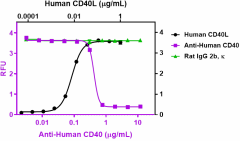- Clone
- W17212H (See other available formats)
- Regulatory Status
- RUO
- Other Names
- Tumor necrosis factor receptor superfamily member 5, TNFRSF5, B-cell surface antigen CD40, Bp50, CD40L receptor, CDw40
- Isotype
- Rat IgG2b, κ

-

Recombinant biotinylated hCD40L (Black circles) binds to immobilized recombinant hCD40 (Cat. No. 777206). Anti-hCD40 antibody (clone W17212H, Purple squares) inhibits the binding in a dose-dependent manner whereas the Isotype control (Cat. No. 400666, Green triangles) doesn’t have the effect. This antibody blocks the binding of 80 ng/mL hCD40L biotinylated protein to 1 µg/mL immobilized recombinant hCD40 with an ND50 = 0.2 - 1 µg/mL.
| Cat # | Size | Price | Quantity Check Availability | ||
|---|---|---|---|---|---|
| 668103 | 100 µg | $270.00 | |||
| 668104 | 1 mg | $715.00 | |||
Select size of product is eligible for a 40% discount! Promotion valid until December 31, 2024. Exclusions apply. To view full promotion terms and conditions or to contact your local BioLegend representative to receive a quote, visit our webpage.
CD40, also known as TNFRSF5, is a type I transmembrane protein that belongs to the TNF receptor family (TNFR). CD40 is expressed on B cells, dendritic cells, monocytes, macrophages, platelets, basal epithelial cells, endothelial cells and a subset of CD34+ hematopoietic progenitors. The interaction between CD40 and its ligand TNFSF5/CD40L leads to the clustering of CD40 and the recruitment of TNFR associated factors (TRAFs), including TRAF1, 2, 3, 5 and 6. TRAF1, 2, 5 and 6 serve as positive regulators while TRAF3 is a negative regulator. CD40/CD40L interaction triggers downstream signaling on both cells, including upregulation of CD40 and cell survival on dendritic cells, upregulation of co-stimulatory molecules, CD80 and CD86 on T cells, and production of inflammatory cytokines. In addition, CD40 regulates B cell development/maturation, Ig isotype switching and in combination with other signals such as IL-4, promotes proliferation. It has been reported that a transcriptional factor, AKNA, can coordinately regulate the expression of CD40 and CD40L. Dysregulation of CD40 is associated with several diseases, such as hyper-IgM immunodeficiency type 3 (HIGM3) and Hodgkin's disease. Targeting of CD40/CD40L for cancer therapy is being evaluated in clinical trials, including anti-CD40 agonist antibodies and soluble recombinant CD40L. Several isoforms have been identified in humans and mice.
Product Details
- Verified Reactivity
- Human
- Antibody Type
- Monoclonal
- Host Species
- Rat
- Immunogen
- Human CD40 Recombinant Protein
- Formulation
- 0.2 µm filtered in phosphate-buffered solution, pH 7.2, containing no preservative.
- Preparation
- The Ultra-LEAF™ (Low Endotoxin, Azide-Free) antibody was purified by affinity chromatography.
- Concentration
- The antibody is bottled at the concentration indicated on the vial, typically between 2 mg/mL and 3 mg/mL. Older lots may have also been bottled at 1 mg/mL. To obtain lot-specific concentration and expiration, please enter the lot number in our Certificate of Analysis online tool.
- Storage & Handling
- The antibody solution should be stored undiluted between 2°C and 8°C. This Ultra-LEAF™ solution contains no preservative; handle under aseptic conditions.
- Application
-
Block - Quality tested
- Recommended Usage
-
Each lot of this antibody is quality control tested by blocking the binding between hCD40 and hCD40L. The ND50 range: 0.2 - 1 µg/mL. It is recommended that the reagent be titrated for optimal performance for each application.
- Product Citations
-
- RRID
-
AB_2814510 (BioLegend Cat. No. 668103)
AB_2814510 (BioLegend Cat. No. 668104)
Antigen Details
- Structure
- Disulfide bond-linked homodimer
- Distribution
-
B cells, dendritic cells, monocytes, macrophages, platelets, basal epithelial cells, endothelial cells and a subset of CD34+ hematopoietic progenitors, primary carcinomas.
- Function
- CD40 regulates B cell development/maturation, Ig isotype switching proliferation. CD40 is also involved in T cell priming and inflammatory cytokine production.
- Interaction
- TRAF1, 2, 3, 5, 6
- Ligand/Receptor
- TNFSF5/CD40L
- Cell Type
- B cells, Dendritic cells, Endothelial cells, Epithelial cells, Macrophages, Monocytes, Platelets
- Biology Area
- Cancer Biomarkers, Immuno-Oncology, Immunology
- Molecular Family
- CD Molecules, Immune Checkpoint Receptors, Soluble Receptors
- Antigen References
-
- Ridge JP, et al. 1998. Nature 393:474.
- Schoenberger SP, et al. 1998. Nature 393:480.
- Bremer E. 2013. ISRN Oncol. 2013:371854.
- Siddiqa A, et al. 2001. Nature. 410: 383.
- Durandy A, et al. 2005. Immunol Rev. 203:67.
- O'Grady JT, et al. 1994. Am J Pathol. 144:21.
- Karaca NE, et al. 2012. Scand J Immunol. 76:21.
- Tone M, et al. 2001. Proc Natl Acad Sci USA. 98:1751.
- Eshel D, et al. 2008. Mol Immunol. 46:250.
- Hostager BS, et al. 2000. J Biol Chem. 275:15392.
- Elgueta R, et al. 2009. Immunol Rev. 229:152.
- Gene ID
- 958 View all products for this Gene ID
- UniProt
- View information about CD40 on UniProt.org
Other Formats
View All CD40 Reagents Request Custom Conjugation| Description | Clone | Applications |
|---|---|---|
| Ultra-LEAF™ Purified anti-human CD40 | W17212H | Block |
Compare Data Across All Formats
This data display is provided for general comparisons between formats.
Your actual data may vary due to variations in samples, target cells, instruments and their settings, staining conditions, and other factors.
If you need assistance with selecting the best format contact our expert technical support team.
-
Ultra-LEAF™ Purified anti-human CD40

Recombinant biotinylated hCD40L (Black circles) binds to imm...
